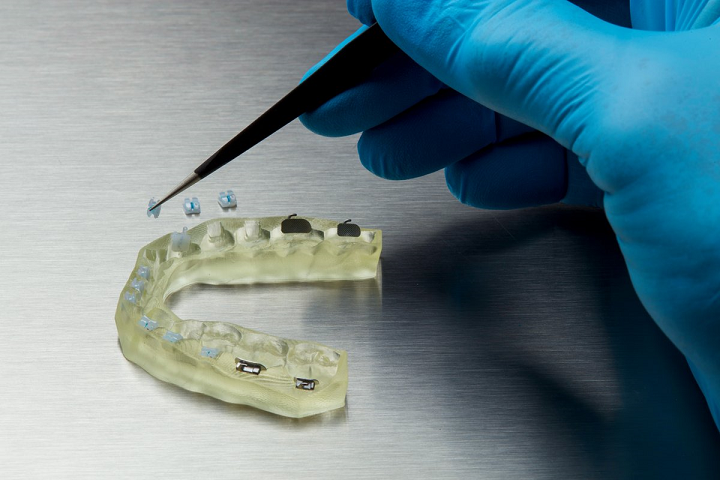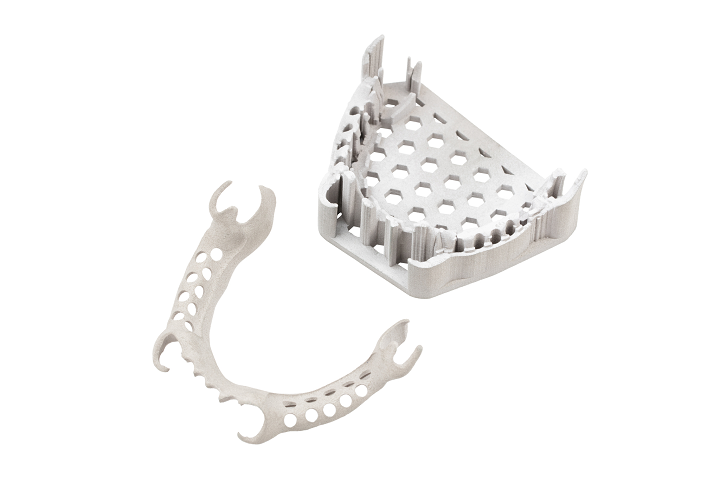Listed by SmarTech Analysis as “one of the most stable and fast-growing opportunities for 3D printing technologies” before the COVID-19 pandemic began in earnest, dental 3D printing was expected to reach $3.1 billion in 2021. With dental 3D printing being such a critical AM application, we asked several experts in the field for their predictions on what would happen with 3D printed dentistry in the coming year.
Formlabs launched its Dental Business Unit in 2019, and offers high-performance 3D printing for dental laboratories, practices, and orthodontics offices, with multiple 3D printer and resin options, learning resources, and a Dental Service Plan. Just in 2021 alone, the company validated its Fuse 1 benchtop SLS system for dental 3D printing, introduced a biocompatible dental resin, and announced a new feature in its PreForm software that will directly convert oral scans into 3D printable dental models.
“Dental practices have been slow to invest in digital impression technology, but the pandemic has accelerated the adoption of this critical first step of digitization due to the advantages of instantaneous sharing of patient records. Once patient impressions become digital, 3D printing is no longer an option for downstream workflows, but a requirement,” Sam Wainwright, Dental Product Manager at Formlabs, told 3DPrint.com. “Since 2016, Formlabs has seen a 460% increase in printers sold in the dental industry, and 2022 will be a landmark year for 3D printing growth as dental practices and labs seek to have on-demand, rapid, manufacturing for these completely digital workflows. With affordable, easy to use 3D printing becoming even more valuable by constant innovation in materials and software, the dental industry is rapidly moving toward full digitization. Soon, 3D printers will become commonplace in the dental industry.”
Although the world slowed down significantly during the pandemic, the dental AM segment began recovering quickly, and continued making positive headlines in 2021, as Stratasys launched its compact, multimaterial J5 DentaJet printer, Materialise released a software module specifically for dental AM, and SprintRay launched a dental resin and post-curing unit. Sandvik acquired a medical and dental 3D printing firm, Japanese manufacturer Roland DGA got back into the 3D printing game with a new dental 3D printer, and Graphy developed a material for directly 3D printed dental aligners.
Desktop Health, the healthcare business launched by Desktop Metal last year, received FDA clearance for a proprietary resin for printing dentures in 2021, and also added the Shop System binder jet 3D printer and cobalt chrome to its dental portfolio. The unit offers a simple, fully integrated 3D printing workflow for digital dentistry, including two 3D printers and immersive training on both, over 60 validated materials, and rapid prototyping software. As Michael Jafar, Desktop Health’s President and CEO, stated, “the dental office is going digital.”
“With almost 50% of U.S. consumers’ last dental visit being prior to the pandemic (2019 or before), the dentist industry will feel like an unfamiliar place for patients as they return in the New Year,” Jafar told 3DPrint.com. “With the increase in digital health within the primary care office, the dental office will embrace new tools to elevate patient experience. Tools like chairside 3D printing of crowns, dentures/teeth (for example) will increase in use, among other tools that provide highly customized experiences while still cutting down the need for revisits.”
Didier Deltort, the President of HP’s Personalization and 3D Printing business, also believes that AM will inject customization into the dental office.
“In 2022 we expect a new era of mass-personalization enabled by digital manufacturing to disrupt a range of large industries, drive innovation, and create new value. Industries ripe for disruption include the highly personalized health and wellness sector. We believe this is a huge growth area as people seek better health outcomes based on their individual needs,” Deltort said.
“Of course, we’ve seen companies like SmileDirectClub in the U.S. and Impress in Europe continue to push the boundaries of oral care using 3D printing to manufacture highly personalized products at scale.”
But, when it comes to boundary-pushing in regulated industries, proceeding with caution can be necessary to keep things safe.
“Due to the highly-regulated nature of the medical and dental industries, the adoption of new and disruptive technologies occurs at a more gradual pace. Accordingly, we typically don’t see revolutionary year-over-year changes, but rather a steady implementation over a multi-year period,” explained Menno Ellis, EVP, Healthcare Solutions, 3D Systems. “With that in mind, we see good continuation and acceleration of current trends into the next year; many of which point towards the increasing use of 3D printing in the space.”
Speaking of trends, Jamie Stover, Senior Manager of Dental Laboratory Applications at Carbon, told us that in “2022 and beyond,” there were a few “closely related” ones for which to watch.
“We may continue to see major staffing shortages in dental labs, despite an enormous amount of work coming due in large part to the growing demand for digitally produced removable appliances such as night guards, bite splints, and dentures.
“We anticipate that the adoption of digital everything — workflows, dental records, and digitally produced appliances — will only grow as well, especially as traditionally trained dental lab technicians age out of the workforce. The industry as a whole needs to double down on recruiting and training a new tech-savvy generation of technicians who can operate the digital tools of additive manufacturing. Along with this new generation of technicians, new and better materials will continue to be developed for 3D printing and we hope to see continued rapid progress in the creation of flexible partials.”
Carbon offers what it calls a “robust 3D printing solution for orthodontics” with its DLS technology, including multiple materials and the L1 printer, which is often used by dental labs to fabricate clear aligner models. In fact, last year the company partnered with oral health digital platform Candid to 3D print models for clear dental aligners.
Another company that understands the importance of 3D printing for orthodontic aligners is Nexa3D; its Co-Founder, Chairman, and CEO Avi Reichental told us that it’s one of the “highest-profile use cases for 3D printing.” He said that dentistry “has never been a one-size-fits-all industry,” but that dental laboratories are “increasingly seeing more and more use for the technology.” Nexa3D introduced its large-format NXD200 3D printer for dental labs in 2021, in addition to partnering with Keystone in order to advance dentistry through 3D printing and announcing a partnership with AI-powered manufacturing software startup Oqton to launch a new dental software to meet the demand for 3D printed patient-specific dental appliances and aligners.
“As we reported in the last edition of The Nexa Level magazine, the American Dental Association reports that the average dentist appointment lasts around 52 minutes. That in-office appointment time could be used to 3D print patient-specific devices like night guards or crowns. Our dental-specific NXD 200 printer can 3D print 16 dental molds using our xModel 2505 material in a 45-minute print job. This can help condense the usual three-appointment scheme – initial visit, consultation, fitting – into a faster route for patients getting on with their life,” Reichental told 3DPrint.com.
“Dental labs that understand the benefits to their patients, and their own calendars, will continue to invest in their own training and equipment. We will see more collaborations with dental material and technology partners arise over the coming year.”

The Nexa3D booth at RAPID + TCT 2021 shows what the company can do for dental industry. Image courtesy of Sarah Saunders/3DPrint.com.
Dental 3D printing is just one of nine critical AM verticals that will be covered in our upcoming Additive Manufacturing Strategies summit, held both online and in-person in New York City from March 1-3. Topics in this session will include dental 3D printer trends, low-cost mass customization in dentistry, using the technology to improve the patient experience, and more. You can register for the hybrid event here and learn more about 3D printing in the dental industry, along with eight other important AM verticals, from a large roster of experts.
Subscribe to Our Email Newsletter
Stay up-to-date on all the latest news from the 3D printing industry and receive information and offers from third party vendors.
You May Also Like
Further Understanding of 3D Printing Design at ADDITIV Design World
ADDITIV is back once again! This time, the virtual platform for additive manufacturing will be holding the first-ever edition of ADDITIV Design World on May 23rd from 9:00 AM –...
3D Printer Maker EVO-tech Reborn as NEVO3D — Once More With Feeling
EVO-tech was a 3D printing service and original equipment manufacturer established in 2013 and based in Schörfling am Attersee, Austria. The company produced high-quality material extrusion systems featuring linear bearings,...
3D Systems Brings 3D Printed PEEK Cranial Implant to the U.S. with FDA Clearance
For more than 10 years, 3D Systems (NYSE:DDD) has worked hand-in-hand with surgeons to plan over 150,000 patient-specific cases, and develop more than two million instruments and implants from its...
CDFAM Returns to Berlin for Second Annual Symposium
The second CDFAM Computational Design Symposium is scheduled for May 7-8, 2024, in Berlin, and will convene leading experts in computational design across all scales. Building upon the first event...


































